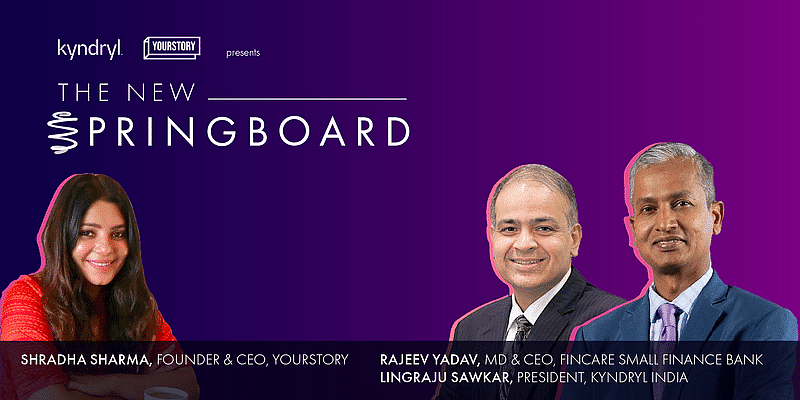Building financial inclusion is a priority for banks and other financial institutions today, particularly for the semi-urban and rural segments. Currently, there are several headwinds and tailwinds that need to be tackled on home ground, as a consequence of tectonic shifts in the global economy. Despite that, there are several innovations that can be witnessed in the fintech space.
In an enlightening conversation, Lingraju Sawkar, President, Kyndryl India and Rajeev Yadav, MD and CEO, Fincare Small Finance Bank discuss the impact of SFBs on the Indian economy, the role of technology in the penetration of banks, and the reality of banking at the ground level, with YourStory’s Founder and CEO Shradha Sharma in the latest episode of ‘The New Springboard’ series. Powered by Kyndryl, the series brings together top leaders from high-potential startups, unicorns, and enterprise businesses to brainstorm ideas and discuss pertinent aspects and perspectives that can springboard growth.
Perception of the Indian economy
There’s no denying that geopolitical tensions at the global level do have a real impact on the financial services in India, believes Rajeev. But at the same time, it’s promising that India is a self-sufficient economy that has been able to tackle inflation pressures consistently.
“I genuinely believe that there is a huge pent-up demand post-pandemic. In terms of customer buoyancy, it is visible in commercial vehicle or personal vehicle sales. Although there are global headwinds, India is reasonably insulated from the global crisis in a local context,” he adds, sharing that their customer base is largely rural and are among the last to experience a direct impact.
In agreement with Rajeev, Lingraju further highlights that the consumption patterns of their clients are proof of the future. Citing the example of the telecom industry, he shares that there is currently a huge demand driven by 5G.
“I see the demand being buoyant in the major sectors. Some of the earlier initiatives of the government have also started to kick in, and there’s the availability of talent today. Things are looking positive,” he adds.
The on-ground reality of financial services
At Fincare, their lending products help them gauge the mood of customers on the ground. Over the last six months, they have observed strong buoyancy on secured loans and stable portfolio performance.
“The industry is going through a recalibration post-launching of the new guidelines by the regulator. Other than that, the customer demand is strong, and we have observed that people want slightly larger ticket loans versus what they were taking earlier. I expect the industry to come back to a good growth rate in this financial year,” explains Rajeev.
Technology has been a key driver in increasing the penetration of small finance banks and the microfinancing segment, believes Lingraju. Traditional banks had built large core banking systems and everything revolved around in-house data; but today, small finance banks do not have the legacy. Instead, they have built systems that are thin and light, and are able to leverage innovation in a unique way to execute faster.
“Also, platforms introduced by the government such as Aadhar and UPI make for good availability of data, especially for monetising. It’s also important to be well-structured, which helps to target the right customer segment and make quick changes on the fly,” he shares.
To watch the full video, Click Here.
The lending landscape
Although there is a distribution of talent across the financial industry, Raeev believes that large institutions function in a more bureaucratic manner than small banks. Fintechs have a clear role to play in the future, particularly in a consumer context. That being said, there is a need for regulatory entities to book the loans.
“Innovation has a role to play in this space. It is a space where you are giving money first and hoping to get it back, a very strong innovative environment could also lead to issues in credit quality or collection practices. But there’s a huge potential for credit to grow. That’s why all the players in this ecosystem will work to bring superior products for customers,” adds Rajeev.
Secured loans have infinite potential, and currently, Rajeev is focused on microfinance loans, affordable housing, and loans against property. Although the deposit franchise is distributed across the country, they are trying to deepen this, even in rural areas.
Future trends
There are three themes that are being addressed today, from a banking perspective, shares Lingraju. The first is customer acquisition, the next is dealing with the regulatory piece, and the last is innovation, particularly in the traditional banking segments.
While small banks like Fincare are trying to build financial inclusion in the country, there’s an interesting observation that their customers are largely women. This helps them become financially smarter, take control of their investment decisions, and gain confidence in how to repay their loans.
When you empower the women of the house, you don’t just lift a family but the community at large, quips Lingraju.
Rajeev is thrilled that they have a challenging problem to solve, keeping in mind the low-cost structures. This makes them nimble, more receptive to digital technologies, and more progressive in their thinking.
The most exciting part today is that India’s leapfrog technology has been the solution to several complicated issues, shares Lingraju. The demographics of the talent and how people are embracing change and adapting to it will take India far ahead.










